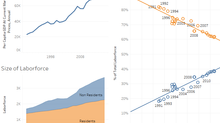Unleashing DeepSeek: How China's Latest AI Innovation is Redrawing the Tech Map

In the fiercely competitive world of artificial intelligence (AI), DeepSeek emerges as a prominent open-source innovation from China, illustrating the nation's escalating prowess in the global tech arena. This cutting-edge AI system not only showcases technological advancements but also poses a potential challenge to other AI giants worldwide, including impacts on international tech stocks such as Nvidia. This article aims to explain DeepSeek, its open-source nature, its origins in China, and its implications in layman's terms.
What is DeepSeek?
DeepSeek is an advanced AI developed in China, designed to excel in data analysis, pattern recognition, and predictive modeling. Utilizing state-of-the-art algorithms, it processes and analyzes vast amounts of data with unprecedented speed, offering deeper insights and more accurate predictions than traditional methods. As an open-source platform, DeepSeek allows developers worldwide to contribute to its evolution, enhancing its capabilities and adapting it for various uses.
The Background of DeepSeek
Created by a consortium led by Liang Wenfeng, associated with the Chinese hedge fund High-Flyer, and based in Hangzhou, Zhejiang, DeepSeek is a product of top Chinese tech companies and academic institutions. Its open-source model not only reflects China's strategic approach to AI but also facilitates a global collaborative platform for AI development.
China's Role in DeepSeek's Development
The development of DeepSeek marks a significant step in China's ambition to dominate the global AI market. By making DeepSeek open-source, China positions itself as a leader in promoting accessible, transparent, and collaborative AI technology. This approach is designed to enhance China's standing in sectors requiring high precision and real-time analytics, such as healthcare diagnostics, financial forecasting, and smart city operations.
The Threat to Other Global AIs
DeepSeek introduces several advancements that challenge established AIs, potentially reshaping competitive dynamics in the AI industry:
Speed and Efficiency:
Detailed Explanation: DeepSeek's ability to process data in parallel rather than sequentially allows it to handle multiple data streams at once, significantly reducing the time required for complex computations. This capability is crucial in industries where real-time data analysis is essential, such as financial trading, where milliseconds can mean the difference between profit and loss, or in emergency services, where rapid response times can save lives.
Impact: Faster processing capabilities could make DeepSeek the preferred choice for applications requiring immediate data analysis, potentially sidelining slower, traditional AI systems.
Accuracy and Depth of Analysis:
Detailed Explanation: Utilizing advanced machine learning algorithms and deep learning networks, DeepSeek is designed to detect subtle patterns and anomalies that might be overlooked by less sophisticated AIs. This capability is vital in sectors like healthcare, where it can predict patient outcomes based on complex datasets, or in cybersecurity, where detecting slight irregularities can prevent data breaches.
Impact: The superior analytical depth provided by DeepSeek may render existing AI models obsolete, especially in sectors where precision and accuracy are paramount.
Versatility and Adaptability:
Detailed Explanation: DeepSeek's architecture is built to be inherently flexible, allowing it to seamlessly integrate and analyze data from various sources—be it IoT devices, online transactions, or satellite imagery. This adaptability makes it invaluable for a wide range of industries, from urban planning and traffic management to personalized marketing and customer service.
Impact: The broad applicability of DeepSeek threatens to displace more specialized AI systems that are designed for narrow or specific applications, as companies may prefer a single, more adaptable AI system over multiple specialized ones.
Cost-Effectiveness:
Detailed Explanation: By leveraging its open-source model, DeepSeek reduces costs associated with AI development and deployment. Organizations can customize the source code to their specific needs without paying licensing fees, and its efficiency in processing and less dependency on high-end hardware reduce operational costs.
Impact: The cost savings from using DeepSeek could encourage a shift away from more expensive, proprietary AI systems, compelling AI firms to reconsider their pricing strategies or risk losing market share.
Market Impact and Nvidia's Stock Turmoil
The launch of DeepSeek, an advanced open-source AI from China, has sent ripples through the global tech markets, particularly affecting Nvidia, a leader in AI processing hardware. Known for its high-performance GPUs essential for AI tasks, Nvidia faces new challenges with DeepSeek's promise of reduced reliance on specialized hardware.
This potential shift could diminish the demand for Nvidia's GPUs, which are traditionally favored for their powerful deep learning capabilities. As a result, financial markets reacted with noticeable volatility in Nvidia's stock as investors speculated on the long-term implications.
Concerns center around DeepSeek's ability to perform complex AI operations more efficiently and cost-effectively, possibly outmoding more expensive, hardware-intensive options. In response, Nvidia might now need to innovate aggressively or diversify its offerings, possibly enhancing software services or forging strategic alliances to maintain its market dominance.
As the industry watches how Nvidia will respond to this emerging threat, the introduction of DeepSeek could mark a pivotal moment, prompting a broader shift in AI development strategies that favor versatility and accessibility over hardware dependency.
Open Source: A Game Changer
The open-source nature of DeepSeek democratizes AI technology. It allows businesses, developers, and academic institutions to access and customize AI technology without the high costs associated with proprietary software. This model fosters a rich environment of innovation and competition, speeding up advancements in AI and offering diverse applications tailored to specific industry needs.
Conclusion
As DeepSeek begins to carve its niche, it represents both an opportunity for global technological advancement and a challenge for existing AI systems to innovate. The open-source model invites a global community to contribute to its development, ensuring that DeepSeek is continually evolving and improving. How will your industry respond to the rise of technologies like DeepSeek? Stay informed and consider the strategic adjustments needed to navigate the evolving landscape of global AI technology.

























Comments